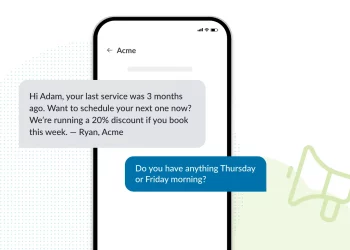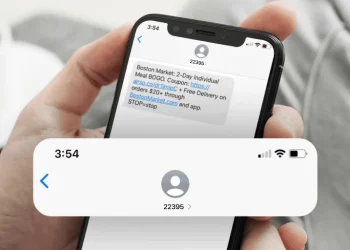In today’s hyper-connected world, where time is of the essence, businesses are constantly searching for innovative ways to communicate with their customers effectively. In this digital age, sending automatic text messages, also known as automated messaging or automated text messages, has emerged as a game-changing strategy for businesses to engage their audience seamlessly and instantly.
This comprehensive guide will unlock the incredible potential of sending automatic text messages in the business world, exploring the unparalleled benefits, intelligent strategies, and essential best practices that will revolutionize your communication approach. Get ready to harness the power of automated messaging and take your business to new heights of success.
The Power of Automated Messaging
Automated messaging enables businesses to send pre-scheduled text messages to their customers or target audience. This technology-driven approach offers several advantages over traditional communication methods:
Instant Communication
Automated text messages allow businesses to reach their customers instantly. With most people carrying smartphones at all times, text messages have a significantly higher open rate than emails, making them an ideal choice for time-sensitive information.
Enhanced Customer Engagement
Personalized messages can foster a stronger connection with customers. Businesses can create more engaging conversations and nurture relationships by tailoring messages to specific individuals or customer segments.
Streamlined Operations
Sending automated messages can streamline business operations by reducing the need for manual outreach. Businesses can automate routine messages instead of spending countless hours on individual communications, freeing up valuable time and resources.
Improved Customer Service
Automated messaging can provide customers with quick responses and support. From appointment reminders to shipping notifications, businesses can keep their customers informed without delay, increasing customer satisfaction.
Implementing Automated Text Messaging
To successfully implement automated text messaging in your business, consider the following steps:
Define Your Objectives
Determine the specific goals you want to achieve through automated messaging. Whether boosting sales, reducing customer churn, or providing timely updates, a clear objective will guide your messaging strategy.
Choose the Right Platform
Select a reliable automated messaging platform that aligns with your business requirements. Look for features such as contact management, message scheduling, personalization options, and analytics to track campaign effectiveness.
Segment Your Audience
Divide your customer base into segments based on demographics, behavior, or purchase history. This segmentation allows you to send targeted messages that resonate with each group, increasing the likelihood of engagement.
Craft Engaging Messages
Create compelling and concise messages that grab attention and prompt action. Incorporate personalization tokens to make messages feel more customized, and include clear calls-to-action to direct recipients toward the desired outcome.
Optimize Timing and Frequency
Timing is crucial in automated messaging. Consider your audience’s time zone, preferences, and habits to schedule messages at optimal times. Additionally, be mindful of the frequency of your messages to avoid overwhelming or annoying your customers.
Test and Refine
Continuously monitor and analyze the performance of your automated messaging campaigns. A/B testing different message variations, subject lines, or delivery times can provide valuable insights for optimization.
Best Practices for Automated Messaging
To maximize the effectiveness of your automated text messages, keep these best practices in mind:
Prioritize Permission-Based Messaging
Ensure that you have explicit permission from recipients to send them automated messages. This maintains compliance with data protection regulations and helps build trust with your audience.
Be Relevant and Personal
Tailor your messages to specific customer segments or individuals. Use their names, reference their recent interactions, or provide personalized offers to make your messages more meaningful and relatable.
Keep Messages Concise
Text messages have character limitations, so keep your messages short, concise, and to the point. Use language that is clear, compelling, and easy to understand.
Provide Value
Offer recipients something of value in your automated messages, whether exclusive discounts, helpful tips, or relevant updates. Providing value builds trust and encourages engagement.
Monitor and Analyze Results
Regularly track the performance of your automated messaging campaigns. Monitor metrics like open rates, click-through rates, conversion rates, and customer feedback. Use this data to identify trends, understand customer preferences, and refine your messaging strategy.
Maintain a Human Touch
While automation is critical, it’s essential to maintain a human touch in your messages. Use language that feels conversational and friendly, and provide options for recipients to reach out for further assistance if needed.
Opt-Out Mechanism
Respect customers’ preferences by including an opt-out mechanism in your automated messages. Give recipients the option to unsubscribe from future messages easily. This ensures compliance with regulations and promotes a positive customer experience.
Continual Improvement
Embrace a culture of continuous improvement regarding your automated messaging strategy. Stay updated on industry trends, experiment with new approaches, and seek customer feedback to enhance your messaging effectiveness.
Case Study: Retail Shop Successful Automated Messaging Campaign
Let’s consider a hypothetical case study of Retail Shop, a retail business, to illustrate the potential impact of automated messaging:
Retail Shop implemented an automated messaging strategy with the following steps:
Objectives:
Their main objective was to increase customer engagement and drive sales by sending personalized offers and product updates to their existing customer base.
Platform:
They chose a robust automated messaging platform that allowed them to manage contacts, schedule messages, and track campaign performance.
Segmentation:
Retail Shop segmented customers based on past purchase history and preferences to send tailored messages.
Message Content:
They crafted concise and compelling messages that included personalized recommendations and exclusive discounts based on each customer’s previous purchases.
Timing and Frequency:
Retail Shop analyzed customer behavior and time zones to schedule messages at optimal times, ensuring they didn’t overload customers with excessive messaging.
Testing and Refinement:
Through A/B testing, Retail Shop experimented with different message variations and tracked the impact on open rates and conversions. They refined their strategy based on the results.
As a result of their automated messaging campaign, the retail Shop experienced a 25% increase in customer engagement, a 20% boost in sales, and positive customer feedback regarding personalized offers and timely updates. The streamlined communication also reduced their manual outreach efforts, allowing the team to focus on other strategic initiatives.
Conclusion
Sending automatic text messages in business has proven to be a valuable tool for enhancing customer engagement, streamlining operations, and improving overall business performance. By following the steps outlined in this guide and implementing best practices, businesses can leverage the power of automated messaging to build stronger customer relationships, deliver timely information, and drive desired outcomes. Embrace this technology-driven approach and stay ahead in today’s competitive business landscape.














